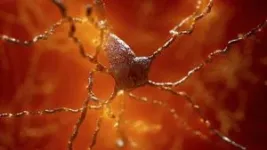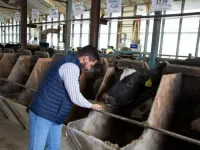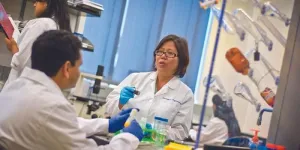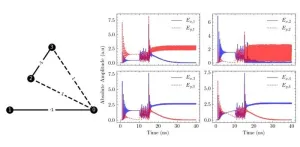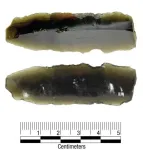(Press-News.org) Parkinson's disease, the second most common type of progressive dementia after Alzheimer's disease, affects nearly 1 million people in the U.S. and an estimated 10 million individuals worldwide. Each year, close to 90,000 new cases of Parkinson’s disease are diagnosed in the U.S.
In a new study, Jeffrey Kordower, director of the ASU-Banner Neurodegenerative Disease Research Center, and his colleagues unveil pivotal insights into the progression of Parkinson's disease, presenting new hope for patients battling the severely debilitating disorder.
The research highlights the role of a critical protein called tau in the early stages of the disease. The results suggest that aggregates of the tau protein may jump-start processes of neuronal damage and death characteristics of the disease.
The findings challenge the conventional view of Parkinson’s disease pathology, which typically focuses on the protein alpha-synuclein as the classic diagnostic hallmark of the disease. The new study illustrates how tau pathology could be actively involved in the degeneration of dopamine-producing neurons in the brain, independent of alpha-synuclein. This revelation could shift the focus of Parkinson’s disease research, diagnosis and treatment.
“Currently, a protein called alpha-synuclein is believed to be the main player in Parkinson’s disease pathogenesis,” says Kordower, who is also a professor with ASU’s School of Life Sciences. “This study highlights that misfolded tau may be the first player in causing the cardinal motor symptoms in the disease.”
The study appears in the current issue of the journal Brain.
Shattering progression
The progression of Parkinson’s disease involves distinct stages, and the timeline can vary significantly among individuals. The typical stages of Parkinson's, as outlined by the Parkinson's Foundation, can help patients understand the changes as they occur.
The disease impacts people in different ways, and not everyone will experience all the symptoms or experience them in the same order or intensity. Some may experience the changes over 20 years or more; for others, the disease advances rapidly.
The progression of the disease is influenced by a combination of genetic and environmental factors. Following a diagnosis, many individuals experience a good response to medications such as levodopa, and this optimal time frame can last for many years. Over time, however, modifications to medication are often needed and symptoms may intensify.
The prevalence of Parkinson’s has doubled in the past 25 years, which may be related to population growth, aging, genetic predisposition, lifestyle changes and environmental pollution.
A fresh perspective
The tau protein accumulates in two regions: the substantia nigra and putamen, both part of the basal ganglia in the brain. The substantia nigra is responsible for the production of dopamine, which is critical for modulating movement, cognitive executive functions and emotional limbic activity.
The putamen, a component of the dorsal striatum, is involved in movement initiation, selection and decision-making, as well as learning, memory, language and emotion. Dysfunction in the putamen can contribute to various disorders, particularly those related to motor function.
A wide range of physical and mental symptoms characterize Parkinson’s disease. These include: rhythmic tremors, often beginning in a limb, such as the hand or fingers; slowness of movement, which can lead to difficulty in performing simple tasks; muscle stiffness or rigidity; and difficulties with balance.
In addition to these physical symptoms, Parkinson's disease can also cause various mental and emotional changes, including depression and anxiety, sleep disorders, memory difficulties, fatigue and emotional changes.
Brain traces of disease
The scientists conducted the study using postmortem brain tissue from older adults who had experienced different degrees of motor impairment. The research analyzed brain tissues from individuals with no motor deficits, mild motor deficits with and without Lewy pathology in the nigral region of the brain, and from individuals clinically diagnosed with Parkinson's disease.
Lewy bodies are abnormal aggregates of the protein alpha-synuclein that accumulate in the brain, and they are a hallmark of several neurodegenerative disorders, including Parkinson’s and dementia with Lewy bodies.
In the case of Parkinson’s, Lewy bodies are primarily found in the substantia nigra, a region of the brain that is crucial for movement control, which leads to characteristic motor symptoms such as rigidity, tremors and bradykinesia (slow movement).
The study focused on a cohort of subjects with mild motor impairments — not pronounced enough to diagnose Parkinson’s, but still significant. Dividing these subjects based on the presence or absence of α-synuclein, researchers found that tau pathology was a common denominator.
The researchers observed that the brain tissue associated with minimal motor deficit demonstrated similar accumulations of tau to those with advanced Parkinson’s, suggesting that tau's role occurs early in the disease's evolution. These findings open doors to earlier diagnosis and intervention, potentially slowing or altering the disease's progression.
The research also sheds light on parkinsonism, a condition that mimics Parkinson’s disease symptoms but is distinct in its underlying mechanisms. The study suggests that tau pathology in the nigrostriatal region of the brain is a shared characteristic, offering a new lens through which to view and treat various forms of parkinsonism.
The findings also underscore the potential of targeting tau pathology as a therapeutic approach in Parkinson’s disease. Because tau aggregation correlates with motor deficits and degeneration of dopamine-producing regions of the brain, interventions aimed at reducing tau accumulation could offer new hope for altering the disease's trajectory.
Kordower is joined by researchers from Neurodegenerative Diseases Research Unit, Biogen, Cambridge, Massachusetts; Aligning Science Across Parkinson’s (ASAP) Collaborative Research Network, Chevy Chase, Maryland; Neurology, School of Medicine, Georgetown University Medical Center, Washington, D.C.; Department of Neurology, University of Alabama at Birmingham; and Pacific Parkinson’s Research Centre and Djavad Mowafaghian Centre for Brain Health, University of British Columbia, Vancouver.
END
New research challenges conventional picture of Parkinson's disease
2024-02-23
ELSE PRESS RELEASES FROM THIS DATE:
Dairy cows fed botanicals-supplemented diets use energy more efficiently
2024-02-23
UNIVERSITY PARK, Pa. — Supplementing the feed of high-producing dairy cows with the botanical extract capsicum oleoresin, obtained from chili peppers, or a combination of that extract and clove oil resulted in the animals using feed energy more efficiently and emitting less methane from their largest stomach, according to a new study conducted by Penn State researchers.
Adding those substances, sometimes referred to as essential oils, to the cattle’s rations resulted in improved efficiency of energy utilization in peak-lactation dairy cows. According to Alex Hristov, distinguished professor of dairy nutrition, ...
Aston University receives nearly half a million pounds to create safer and greener batteries
2024-02-23
• Researchers to explore the use of gel electrolyte materials to improve lithium-ion batteries
• The batteries are the most commonly used in electric vehicles and electronics
• Will use non-harmful, non-flammable and renewably sourced materials for next generation battery technologies.
Aston University researchers are to explore the use of gel electrolyte materials to make lithium-ion batteries - the most commonly used for electric vehicles and electronics - safer and less environmentally damaging.
The University has received a grant of £443,058 from the Engineering and Physical Sciences Research ...
New study shows glycan sugar coating of IgG immunoglobulin can predict cardiovascular health
2024-02-23
When people hear about predicting heart disease, most will think of cholesterol levels. While cholesterol is a major contributor to heart disease, a recent study from Brigham and Women's Hospital, a founding member of Mass General Brigham, found that a glycan biomarker of IgG is also an important predictor for cardiovascular diseases (CVD). The researchers studied the sugar coatings on an antibody known as immunoglobulin G (IgG), which is implicated in the immune responses associated with chronic inflammation among participants in two case-control studies. The results of this investigation provide another biomarker for identifying risk of CVD, which could lead to earlier diagnosis ...
Sir Peter Rigby appointed as honorary chair of Aston University’s new Digital Futures Institute
2024-02-23
Sir Peter was knighted for his contribution to IT and businesses in the Midlands in 2002
He will provide guidance, support, advocacy and strong links to industry in his role
The Institute will drive digital innovation and ensure digital inclusion.
Aston University is delighted to announce that it has appointed one of the UK’s most respected and successful business leaders, Sir Peter Rigby, as honorary chair of its new Digital Futures Institute.
The announcement of Sir Peter’s appointment was made in front of guests at the inaugural lecture given by Professor Abdul Sadka, director of the Digital ...
Yale School of Medicine receives a $575,000 grant from PolyBio Research Foundation to fund long COVID research
2024-02-23
Yale School of Medicine and its Center for Infection & Immunity (CII) are receiving a $575,000 grant from PolyBio Research Foundation to fund Long COVID research. The grant—issued via PolyBio’s LongCovid Research Consortium (LCRC)— will support a collaboration to define mechanisms by which the SARS-CoV-2 virus can persist for long periods of time in tissue and blood.
There is growing evidence that SARS-CoV-2 may not fully clear from Long COVID patients after initial infection. Instead, reservoirs of the virus can persist in patient tissue for months or even years, with recent research finding the SARS-CoV-2 ...
Common plant could help reduce food insecurity, researchers find
2024-02-23
UNIVERSITY PARK, Pa. — An often-overlooked water plant that can double its biomass in two days, capture nitrogen from the air — making it a valuable green fertilizer — and be fed to poultry and livestock could serve as life-saving food for humans in the event of a catastrophe or disaster, a new study led by Penn State researchers suggests.
Native to the eastern U.S., the plant, azolla caroliniana Willd — commonly known as Carolina azolla — also could ease food insecurity in the near future, according to findings ...
Innovative chemotherapy approach shows promise against lung cancer
2024-02-23
Lung cancer is not the most common form of cancer, but it is by far the deadliest.
Despite treatments such as surgery, radiation therapy and chemotherapy, only about a quarter of all people with the disease will live more than five years after diagnosis, and lung cancer kills more than 1.8 million people worldwide each year, according to the World Health Organization.
To improve the odds for patients with lung cancer, researchers from The University of Texas at Arlington and UT Southwestern Medical Center have pioneered a novel approach to deliver cancer-killing drugs directly into cancer cells.
“Our method ...
Encoding computers of the future
2024-02-23
In our data-driven era, solving complex problems efficiently is crucial. However, traditional computers often struggle with this task when dealing with a large number of interacting variables, leading to inefficiencies such as the von Neumann bottleneck. A new type of collective state computing has emerged to address this issue by mapping these optimization problems onto something called the Ising problem in magnetism.
Here's how it works: Imagine representing a problem as a graph, where nodes are connected by edges. Each node has two states, either +1 ...
Artifact could be linked to Spanish explorer Coronado's expedition across Texas Panhandle
2024-02-23
DALLAS (SMU) – It’s a small piece of obsidian, just over 5 centimeters long, likely found on a hard-scrabble piece of ranchland in the Texas panhandle. But when SMU anthropologist Matthew Boulanger looks at it, he gets a mental image of Spanish explorer Francisco Vasquez de Coronado making his way across the plains more than 470 years ago in search of a fabled city of gold.
Boulanger believes that the flaked-stone tool with its sharp edge was likely dropped by a member of Coronado’s ...
Do’s and don'ts with direct oral anticoagulants
2024-02-23
Direct oral anticoagulants (DOACs) are a common treatment for patients with a wide variety of cardiovascular conditions. DOACs are the preferred treatment over vitamin K antagonists (VKAs) for many patients with atrial fibrillation or venous thromboembolism, since the latter would have a higher risk of intracranial bleeding and more complex dosing routine. However, new research suggests that DOACs should not be the first line of treatment for every patient who need to treat or prevent blood clots. A systematic overview from researchers at Brigham and Women’s Hospital, a founding member of Mass General Brigham, discusses the efficacy ...

